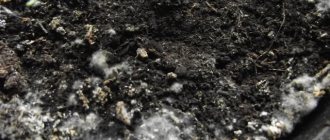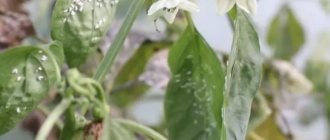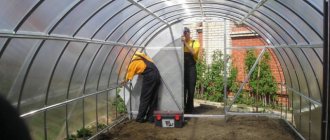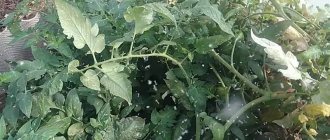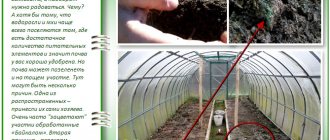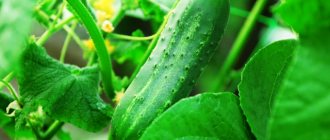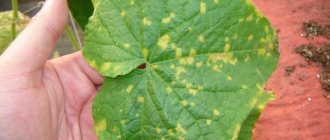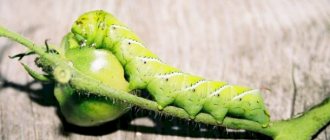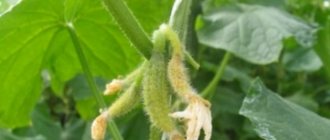Don’t rush to panic - white mold on the ground under seedlings is not always dangerous. Most often, this is a harmless fungus that does not directly threaten young plants, does not damage their roots and does not slow down growth. But if there is a lot of it, then you definitely need to fight.
This is what healthy seedlings and soil for them look like.
We'll tell you what kind of mold can be on the ground under seedlings and how it differs from dried salt - efflorescence. Let's talk about what means you can use to cultivate the soil, containers, and peat pots. Let's name drugs that many people recommend, but should absolutely not be used
What is mold, its types and characteristics
Mold is a name given to microscopic fungi that grow on different surfaces and can be of different colors. They reproduce by spores, which are found absolutely everywhere in nature and just wait for favorable conditions for growth. Molds feed on nitrogen, simple carbohydrates, and other substances and cannot move through space in search of food. Therefore, spores “settle” where there is a nutrient medium.
Plant and vegetable growers most often encounter white mold - colonies of saprophytic fungi. They feed on dead tissue of plant or animal origin, do not penetrate living tissue, and therefore do not directly harm seedlings.
What other types of plaque can there be?
When growing seedlings under glass, in a greenhouse or hothouse, a green coating appears on the surface of the ground, mistakenly called mold. In fact, this is a type of algae that is also not dangerous for plants. Their presence only indicates that the plant has enough sunlight and the soil is saturated with nutrients. You only need to deal with algae when it starts to bubble. In this case, it is enough to reduce the volume of water and the frequency of irrigation.
This is what moss looks like in a garden bed. It's not mold.
The appearance of moss in seedlings indicates that the soil is low in nitrogen and has an acidic reaction. Most often, moss grows when an inexperienced gardener applies a lot of phosphorus fertilizers. It is easy to distinguish moss from algae: the latter look like greenish mucus and occasionally gather in lumps.
Read about how to remove moss from your property.
In regions with hard or chlorinated water, the ground under the seedlings may become covered not with mold, but with efflorescence - salt deposits. It looks as if the surface of the soil was unevenly dusted with flour or ash. The phenomenon itself is not dangerous for young plants, but it signals a change in the soil reaction towards alkaline. In these cases, the soil is artificially acidified with a solution of citric acid or vinegar.
How to distinguish mold from other types of plaque
The first and main way is to look at the type of plaque. The mold will look like many microscopic filaments forming a furry cap on the surface. Sometimes this phenomenon is compared to a spider's web. It is often white or gray in color. Mosses, algae and efflorescence look completely different.
You can take part of the plaque, rub it between your fingers and look at the result:
- The mold will simply clump into a ball or break up into individual fibers. When rubbed, a specific moldy smell appears.
- The algae will spread between your fingers in a thin layer.
- The efflorescence will be ground into powder.
It would also be useful to look at how plaque covers the ground under the seedlings. Mold prefers to settle along the edges of the container, along its walls, and less often chooses holes between lumps of earth. Efflorescence often covers the entire surface where water gets during irrigation. Mosses can also settle near seedlings, and algae often choose a place around the perimeter of the container.
This is what efflorescence looks like, which novice gardeners confuse with mold.
Why is white mold dangerous for seedlings?
White mold, a saprophytic fungus, often appears in glasses with seedlings. He is a constant companion of any organic matter. Therefore, if you grow plants on nutrient mixtures, as well as on coffee grounds, tea, compost or humus, the likelihood of a white coating is very high.
Without destroying the plant, white mold can pose an indirect danger to it:
- It will begin to take away nutrients, especially nitrogen. Plants and mold need the same components to thrive.
- If the colony is large, there will be a moisture deficit in the soil.
- Covering the entire surface of the container, white mold disrupts air exchange in the soil and deprives the plant of some sunlight.
Fungal spores are highly resistant to external environmental conditions and do not freeze out in winter. If no measures are taken, there is a risk that this problem will recur next year.
The appearance of white mold signals that favorable conditions have been created for the development of other fungi. For example, causing black leg or root rot in seedlings.
If you still need to replant indoor plants
If the above measures do not help, it is possible that the plant will need replanting.
Carefully dig the flower out of the ground. Treat the roots with a weak solution of potassium permanganate.
The soil affected by mold should be thrown away and the pot should be disinfected. If it is ceramic, you can keep it in the oven, or pour boiling water over it. Please note that plastic pots are difficult to disinfect, and there is a good chance that it will not be possible to completely remove fungal spores from them.
Place a few centimeters of drainage at the bottom of the pot - you can buy it in special stores such as Priroda. Drainage should be followed by soil, also purchased at the store (give preference to “light” soils, with a lot of peat).
After that, plant the plant.
Causes of mold in the soil under seedlings
Mold spores are everywhere, they can also be found in the soil. To activate their growth, several conditions must be met:
- High humidity. In the case of seedlings, it may be due to overwatering, poor drainage, or insufficient drainage holes in the bottom of the container.
- Insufficient ventilation in the room. If the greenhouse or greenhouse where seedlings are grown is not regularly ventilated, mold will feel more at ease.
- Relatively low air temperature combined with high humidity.
If the soil or substrate under the seedlings is not loosened, and disintegrants (river sand, agroperlite, vermiculite) were not used when preparing the mixtures, then it will be easier for mold to develop.
Mold in a container with seedlings.
Why do animals eat and dig?
Usually, young Alabai puppies and kittens, who are just exploring a new world and trying to taste everything, dig or eat soil, grass, and coal. How to wean a puppy or child if he climbs and scoops up the soil? The animals are driven by ordinary curiosity, so after several attempts to eat the earth, everything stops. The toy terrier puppy will understand that the soil is not tasty and will not try it anymore. However, this sign is not curiosity, but the cause of the psychological state of the dog or cat. This happens because the animal does not feel comfortable in the house or has a dislike for the new family member.
Perhaps the owner treats the cat or dog poorly, punishes him, and he takes revenge in this way. Sometimes animals chew and tear furniture, walls or shoes of their owner. Therefore, in order to understand why an animal licks clay and sand, digs or eats soil from a flower pot, it is necessary to examine its health, for example, for feline anemia. If the reasons lie in the animal’s personal hostility or psychological discomfort, then the owner and his household should give the pet more affection. It is very important to communicate more with your pet, spend time with him, praise him, and play with the animal.
How to remove mold from the ground under seedlings
Not all methods that are available on the Internet are equally effective against mold and are safe for the plant. Here is their rating (the most useful tools are collected at the top):
- Dust the soil with ground cinnamon. This spice contains cinnamaldehyde (cinnamaldehyde), a natural fungicide. It inhibits mold growth and is harmless to the soil.
- Temporary change in watering regime. The seedlings are not watered until the soil dries to a depth of 5 cm.
- Place the seedlings under the sun or lamps to dry the containers. If it’s warm outside, you can take the pots out all day: at the same time, hardening will occur.
- Mulching seedlings with a mixture of activated carbon and wood ash mixed in a 2:1 ratio. The thickness of the layer is 1–1.5 cm. To avoid burning the plants, you need to step back 2–5 cm from the stem.
- Mulching with dry river sand. It is best to dry it in the oven, let it cool, then scatter it in a layer of up to 2 cm and mix it with the soil by loosening it.
- Mulch with crushed activated carbon in a layer of up to 2 cm, then pour a layer of clean soil on top.
- Replacement of the top layer of soil with fresh one. It is better to take the soil mixture from the store, but it may also contain mold spores.
- Dust the soil in containers with baking soda. Do not let it get on the green parts of the plant - it can cause a chemical burn.
If these methods do not help, and white mold covers the entire surface of the earth, you will have to take radical measures - transplant the seedlings into another container, with a large number of drainage holes and fresh soil. It’s good if it’s time to do the picking, then the plant will experience less stress.
Fitosporin is the best drug for fighting fungi.
Article: TOP 5 soils for seedlings.
Traditional methods
Remedies from this category will work effectively if a white coating has recently appeared on a cactus or other plants (early stages of the disease) or as a preventive measure.
- Dissolve 25 g of soda ash and 5 g of liquid soap in 5 liters of hot water. Let the prepared liquid cool. Spray the top layer of soil and the plant with the cooled solution 2-3 times. The interval between spraying is a week.
- 1 tbsp. l. baking soda and half tsp. Dissolve liquid soap in 4 liters of water. Spray the plant and soil 2-3 times. The interval is 6-7 days.
- Dissolve 2.5 g of potassium permanganate in 10 liters of water. Use 2-3 times. The interval is 5 days.
- 100 g of fresh horsetail pour 1 liter of water. Wait a day. Place on fire and boil for 1-2 hours. Strain, cool, dilute with water (1:5) and treat the bushes. Store the solution for no more than a week in a dark, cool place. Spraying can be carried out regularly as a preventive measure in spring and summer. During the disease (in the early stages), plants are treated 3-4 times. Frequency – once every 5 days.
- Dilute 5 g of copper sulfate in 250 ml of hot water. Dissolve 50 g of soap separately in 5 liters of warm water. Pour the solution with vitriol into the soapy liquid in a thin stream, stirring constantly. Spray the plant 2-3 times with the prepared product. The interval is 6-7 days.
- 1-2 tbsp. l. Pour dry mustard into 10 liters of hot water. Water or spray the plants with the cooled solution.
- Stir 1 kg of ash in 10 liters of heated water. Let the solution brew (3-7 days), stir it regularly. Drain the water into a clean container, add a small amount of liquid soap and pour into a spray bottle. Treat plants 3 times every day or every other day. The remaining liquid in a separate container, which has been drained from the finished product, can be further diluted with water and subsequently used for irrigation.
- Fill rotted manure (preferably cow) with water (1:3). Let it brew (3 days). Dilute with water twice and spray the bushes.
- Pour 25 g of chopped garlic into 1 liter of water. A day later, when the product has infused, strain and spray the plants.
Preventive treatment of seedlings against mold
White mold is most often not dangerous, but there may be spores of pathogenic fungi in the soil. To protect seedlings from diseases, they can be treated with fungicides.
Table: fungicides and other means for treating seedlings against fungi.
| Name | Scope and description |
| Fundazol | For the prevention of black leg and various root rots |
| Binoram F | Microbiological fungicide that works against root rot and other fungal diseases. Has growth-stimulating properties |
| Planriz | Biofungicide against black leg, rot, bacterial and fungal diseases. |
| Fitosporin | A biofungicide effective against root and basal rot caused by various fungi. |
For private household plots (private farmsteads, summer cottages, small greenhouses), it is enough to treat the seedlings with Fitosporin or Planriz - these are modern, proven fungicides.
Less effective against mold are a light pink solution of potassium permanganate and a solution of hydrogen peroxide (5 ml/1 l of water). You can spray the seedlings with a 3% solution of copper sulfate.
What drugs should not be used to combat mold?
Oxychom helps in the fight against late blight, alternaria and downy mildew on adult cucumbers and tomatoes; seedlings are not treated with it.
There is no point in using Metronidazole and Trichopolum against mold. These are drugs intended to treat bacterial infections in people; they will not save seedlings. Nystatin is also prohibited from using to treat seedlings.
There is visible mold on the left side of the photo.
Medical antibacterial and antifungal drugs are not intended for use in vegetable growing and can therefore be hazardous to human health.
Backfilling with moisture-absorbing material
Before starting a “rescue operation”, it is necessary to eliminate the main lesions. To do this, you need to remove the top layer of soil with the bulk of the mold. If the spores have not penetrated deep into the pot, then you can stop panicking and take care of preventing new mushrooms.
Bulk materials are ideal for combating mold and preventing fungal growth. Perlite, vermiculite, fine expanded clay, and river sand have two excellent qualities: moisture holding capacity and breathability. They are able to absorb excess moisture and promote better ventilation of the soil in the pot, preventing stagnation of water, which gives rise to fungus.
The surface of the affected pot must be covered with one of the bulk materials. For the best effect, you can add about 30% perlite or river sand to the soil the next time you replant. Sphagnum moss also has the ability to absorb excess moisture. You can lay the surface of the soil with pieces of moss, which will restore the water and acid balance in the pot with the plant.
How to remove mold from peat pots
If mold has spread over the surface of the peat pot, it will be almost impossible to deal with it. Its hyphae grow deep into the material; not a single drug will get there.
You can also try:
- Spray the walls outside and along the perimeter inside with Fitosporin or a similar preparation (Alirin B, Baxis).
- Gently wipe the pots with a soft cloth soaked in soda solution.
- Spray the pots with hydrogen peroxide.
If the seedlings are already large, then you can carefully transfer them to new pots filled with soil mixture, and burn the old containers outside the site.
Preventing mold from growing under seedlings
The basic rules for preventing white mold under seedlings are easy to follow:
- Do not overwater the seedlings. It is believed that ¼ of the volume of soil in the container should be dry. That is, if the thickness of the earthen layer in the pot is 20 cm, the first 5 cm should be almost dry.
- To protect seedlings from excessively humid air, you need to regularly ventilate the greenhouse. When growing seedlings at home, you can place a small fan nearby and turn it on briefly several times a day.
- Do not use vinegar to prevent mold. Fungi tolerate even a sharp increase in the acidity of the environment.
- Ensure good drainage of water from the glasses under the seedlings. To do this, make drainage holes with a diameter of 5–15 mm. their number depends on the crop being grown.
- Do not keep containers with seedlings in trays filled with water for a long time.
Pre-sowing seed treatment will not protect against the appearance of mold on the ground. Disinfecting soil and store-bought soil mixtures by calcination or steaming will do more harm than good. Along with fungi, which may not be pathogenic, bacteria beneficial to plants are destroyed.
It is visually difficult to determine whether it is mold, moss or algae.
If there are suspicions about the quality of the soil, it is better to irrigate it with a solution of Trichodermin or Fitosporin.
There is no guarantee that purchased soil or garden soil does not contain mold spores. Therefore, it is important to pay attention to measures that can prevent its occurrence. To do this, you need to monitor humidity, provide sufficient lighting and the air temperature necessary for the crop. If mold appears in pots, you can sprinkle the ground with ground cinnamon, crushed activated carbon, or pour the surface with solutions of modern fungicides.
Prevention.
As part of preventive measures, it is necessary to constantly analyze the condition of the indoor plant, not only the soil, but also its appearance. If mold is detected, you can use certain drugs to prevent this fungal disease. When using medications, follow safety precautions. Since many drugs have a hazard class. And when using some that are prohibited from being used at home, special processing conditions must be observed.
To prevent mold from appearing in your flower pot, monitor the watering schedule and do not overwater your plants. And if some plants require abundant watering, drainage must be maintained in the pot. For preventive purposes, when watering, you can use weak solutions of drugs that are diluted in water for irrigation. And if all these points are observed, problems with mold should not arise. Good luck to you.
